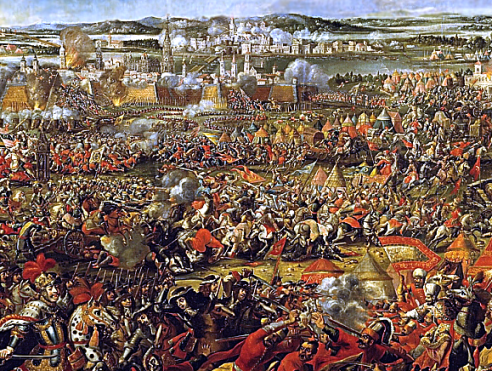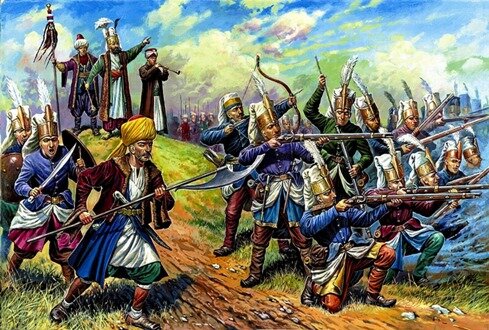Jan Sobieski
"I came, I saw, God conquered."
I may have mentioned this before, but even though I get shitloads of email from all around the world two of the biggest non-English-as-a-Primary-Language supporters of Badass of the Week come from the good people of Poland and Turkey. While some of you might think this is a really weird combination, it actually makes a lot of sense – these are two ultra-badass historical military powers, each of which features centuries of hardcore asskicking motherfuckers who blasted the shit out of their enemies on battlefields across the globe, yet never seem to get the respect and attention they deserve from stick-up-the-ass military historians who can’t get a boner for any warrior that was born east of Berlin. Centuries of lock-step Polish battlefield prowess get boiled down to DURRR HORSES CHARGED PANZERS LOL, and even though the Turks conquered the entire Middle East, North Africa, and half of Europe and fought off multiple invasion attempts as recently as Gallipoli you still can’t order a shawarma in Oxford without some fool talking about “The old sick leprous wretched corpse-man of Europe.” It’s fucked up.
Well this week I get the honor of talking about the high-water mark in both of these countries’ epic military history – the Battle of Vienna in 1683. A hardcore, blood-and-guts conflict that marked the furthest expansion of the Ottoman Empire as well as the most glorious military accomplishment in Polish history, when two all-time shit-wrecking civilizations went sword-to-sword and didn’t stop face-shanking until the entire battlefield was littered with slain warriors and carnage.
WHAAAAAAAT
The tale begins in Belgrade, in the year 1683. For the last few centuries the Ottoman Turkish Empire has been the dominant force in Asia and East Europe, with all-powerful Turkish Sultans and their hardcore armies of Janissary riflemen stomping fucking scrotums left and right from Morocco to Hungary. Constantinople has fallen, Turkish hordes have swept aside resistance in the Balkans and Hungary, Budapest is in Ottoman control, and the Pope is shitting a brick just thinking about the prospect of the great Sultan once again turning faithful Christians into something sort of resembling the contents of a chunky can of dog food.
A few years back, under the capable eye of Suleiman the Magnificent, the Turks had made it to the gates of Vienna. Fucking Vienna, like Mozart and shit, and here were the Turks thinking about bulldozing it to the ground with artillery and building a mosque on the smoldering ruins. Suleiman had gotten close – really close – but in 1683 it was the Sultan Mehmed IV who had his eyes on the prized possession of the Holy Roman Empire. He dispatched his Grand Vizier, an almost-universally-despised dude named Kara Mustafa who was far more interested in amassing personal glory than in kicking balls for the Sultan, and sent him on the march with 200,000 of the toughest warriors the Turks had to offer (numbers on the size of this army range from 90,000 to 300,000, so who knows). Badass Janissaries, heavy artillery, Mongol warriors from Crimea, and even Romanian and Hungarian knights headed out to exert the Sultan’s dominance over the godless Christian infidels of the West.
EPIC HEADGEAR
A Holy Roman Empire army marched to face the Grand Vizier, but the forces of the Duke of Lorraine were ridiculously outnumbered as fuck at and at the Battle of Petronell in July 1683 they were thoroughly beaten down and had two Imperial Princes killed in action. The Duke of Lorraine withdrew in a hurry, and Kara Mustafa was besieging Vienna in under a week. The Holy Roman Emperor Leopold just happened to be chilling in Vienna when this shit went down, and barely managed to bravely flee the city before the Turkish artillerists were bombing cannonballs in his face. In his wake he left behind one of the biggest and richest cities in his empire, which at this point was defended by the brave General Ernst Rudiger, Count of Starhemburg, whose 16,000 soldiers were supported by 8,000 civilian fighters and 700 able-bodied students from the University of Vienna.
Opposing them was a massive field of 200,000 Turkish warriors who had spent the previous couple generations perfecting the art of reducing enemy cities to rubble and plundering them with impunity.
Grand Vizier Kara Mustafa ordered his men to begin the siege. They immediately got to work digging trenches, building fortifications, setting up their cannons, and digging massive tunnels to undermine the walls of the lightly-defended city.
Enter the greatest King in Polish history – John III Sobieski, better (and more accurately) known as Jan Sobieski. A big guy with an awesome 'stache who looks like he'd be more at home as the protagonist in a Root Beer Tapper clone than at the head of a formation of badass lance-wielding heavy cavalry. But Sobieski isn't about to dole out old-timey folk wisdom behind the bar while wiping down a frosty mug with a cloth towel – he's a fucking hardcore lifetime warrior who cut his teeth battling scimitar-wielding Cossack horsemen and charging head-on into Mongol cavalry formations at the head of a terrifying regiment of Winged Hussars that he raised with his own money.
Oh, and if you forgot who the goddamn Winged Hussars are, let me refresh your memory:
At the Battle of Beresteczko in 1651, Jan Sobieski led the Hussars in an attack that smashed the light cavalry formations of the Ukrainian Cossacks. In 1664 he battled Swedish invaders at the gates of Warsaw. In 1667 he led warriors against the Mongol Tatars, raising 8,000 men with his own money and successfully defending the city of Podhajce against 20,000 steppe horsemen with the sheer force of his own impenetrable fucking steel ballsack. At Chocim he destroyed 20,000 Turkish front-line warriors and captured over 100 pieces of artillery, an heroic asskicking that made him such a national hero that he was elected King of Poland a year later based on his own popularity alone. Known as "The Unvanquished Northern Lion", by a Turkish army that had the good sense and honor to appreciate a righteously-hardcore badass even when he wasn't fighting under the same flag, Jan Sobieski had fought his way to the Crown on military awesomeness alone, then went home at the end of every day to share a bed with a fucking hot French countess he'd brought in straight from the court of Louis XIV.
And, more importantly even than his track record kicking ass in the name of Poland, Jan Sobieski was a man of honor. So when the Pope sent him a letter desperately requesting he send aid to the battered defenders of Vienna, Sobieski assembled every single goddamn warrior he had – at the expense even of garrisoning his own cities against attack – and personally rode to the rescue at the head of a force that was 20,000 men strong.
Let's do this.
Back in Vienna, things were bad. Real bad. The Turks, masters of siege warfare, were smashing the walls to cinders with their heavy artillery. Boasting the best gunners and heavy infantry in the world, the Turks were also trench and mine warfare experts, and they had their hard-as-nails sappers digging intense tunnels under the walls of Vienna, stuffing them with gunpowder, then blasting them open to create breaches in the defenses. Sometimes the Viennese dug counter-tunnels, with led to what-the-hell-is-even-going-on underground D&D sword-and-gunfight battles that took place 10 feet underground in a space roughly four feet across, like something out of a Vietnam movie or some Iwo Jima shit. Still, the walls held. The Viennese fought back with everything they had, desperately resisting the impressive Turkish onslaught. They were ravaged by disease, barfing their guts out and disintegrating from plague. They were losing key bastions and positions and trenches daily. Still, for 30 days, they held.
Then, on September 2nd, the Turks heroically stormed a hail of gunfire to take the Burg Ravelin – the crucial defensive point on the Vienna walls. Four days after that, another mine blew up, bringing down an outer wall, and the Turks assaulted it and overran the beleaguered, sick defenders in yet another trench just outside the city gates.
This point officially marks the high water mark of the Ottoman Empire. For all intents and purposes, they'd done it. Even General Rudiger and those Vienna University Halo-playing stoner-soldiers knew it. The Turks had taken the walls. They had Vienna dead to rights. The gateway to the West was about to be open. Tonight, they would sleep in Vienna, on enemy soil.
Yet, somewhat amazingly, Grand Vizier Kara Mustafa waited. For some stupid reason, he didn't order the final attack.
The reigning theory is that Vizier Mustafa wanted the glory for himself. He knew that Vienna was dead, but if he assaulted it he'd have to split all the loot with his men who had fought so hard for it. If he got the Viennese to surrender, he'd get all the glory and riches for himself. So he demanded surrender. Rudiger told him to fuck off.
Then, on the morning of September 12th, 1683, almost a week after he should have stormed the walls, Grand Vizier Kara Mustafa turned to his right flank and noticed something he wasn't really expecting.
King Jan Sobieski of Poland. And 76,000 Polish, German, Saxon, Bavarian, and Imperial troops riding hard behind him.
HEY YOOOOOOOOOO
The Turks fought like heroes, adjusting to their flank attack and resisting with everything they had, but once again Kara Mustafa fucked them. Rather than redirect all 200,000 guys to repel the attack, he kept half his guys in the trenches facing the city and somehow thought he could hold back the largest cavalry charge in human history with only half his force.
It didn't work. Racing down from the hills as hard as he could, Jan Sobieski led an epic attack of heavy European cavalry through the Wienerwald Forest (hahahahaha) and straight into the flank of the Turkish formation. The Turks battled bravely. They didn't break right away. For several hours the infantry of the Turks, known for their hard fighting, battled like the kind of warriors who conquer kingdoms. But in the end, the mighty Poles were too much. Sobieski raced ahead, Hussar wings fluttering behind him, on a final charge that smashed through them, cut off their flank, sacked their baggage train and forced the Turks to flee. They withdrew in good order – their defeat had been decisive and total, but hadn't inflicted an insane number of casualties.
Still, Sobieski rode into the gates of Vienna a hero. The Savior of Christendom. Because he totally was.
Jan Sobieski drove the Turks back to Romania, and for his failure and dipshittitude the Grand Vizier was choked to death with a bowstring on the streets of Belgrade on the orders of Sultan Mehmed IV. Sobieski returned home and won fame with his people for promoting poetry, painting, and art, and for signing "Eternal Peace" documents both with Russia and Germany (even though neither of these lasted very long). He is still remembered as the unsung hero of Western Civilization, because without his military might and ball-stomping cavalry we'd probably all be speaking Turkish at this point.
And that's something we should all keep in mind when we think about the great military civilizations in history – if it wasn't for the Poles, the Turks would potentially have ruled Western Europe.
Links/Sources:
http://www.britannica.com/EBchecked/topic/304774/John-III-Sobieski
http://www.newadvent.org/cathen/14061c.htm
http://en.polska.pl/Jan,III,Sobieski,%281629,%E2%80%93,1696%29,1964.html
Agoston, Gabor and Bruce Alan Masters. Encyclopedia of the Ottoman Empire. Infobase, 2009.
Grant, R.G. Commanders. DK Publishing, 2010.
Halecki, Oskar, and O. Forst de Battaglia. The Cambridge History of Poland. Cambridge University Press, 1971.
Millar, Simon. Vienna 1683. Osprey, 2008.
Young, William. International Politics and Warfare in the Age of Louis XIV. iUniverse, 2004.









